This street in Tomar is called Rua do Centro Republicano which is English can be translated to Republican Centre Street. The word ‘republican’ means a lot to Portugal as in 1910 the country decided to change from a monarchy into a republic. In my view this is important because in 1580, due to the death in battle of the young King of Portugal Dom Sebastião, without heirs the kingdom of Portugal was disputed by the king’s cousin who was the King of Spain, Philip II. As a result Portugal ended up losing its independence to Spain for 60 years. Since Spain is now a monarchy and Portugal is a Republic, the danger of Portugal losing its independence again due to monarchy heritage doesn’t exist any more.

Rua do Centro Republicano in Tomar is a medieval street, covered with cobblestones

Close to Rua do Centro Republicano is the Sports Pavilion of Tomar and Mouchão Park

Rua do Centro Republicano which in English can be translated to Republican Centre Street is full of commerce like hairdressers, insurance companies, electrical equipment, etc
This is Travessa do Arco, another medieval street in the City of Tomar, paved with cobblestones. There was a time cars were allowed to circulate and even park in this alley but in 2010 given how narrow is this lane, the Town Council of Tomar deliberated to forbid most traffic with the exception of loading and unloading goods. There is an 500 years old palace here called Palácio dos Velhos de Macedo whose owner, Mr. José Maria Shearman Velho de Macedo has written to me last year.

Travessa do Arco in the City of Tomar. Close by there is a five hundred year palace called Palácio dos Velhos de Macedo

The Town Council of Tomar in 2010 forbade the circulation and parking of cars at Travessa do Arco

At the end of Travessa do Arco (Arch Lane) in Tomar, is a street called Avenida Cândido Madureira.
This a small and old street in Tomar and it’s called Rua do Camarão. I’m not sure why this street is called like that as Camarão means shrimp. I know that these crustaceous can be found not only in salt water but also in fresh water, but I’ve never heard of shrimps living in the waters of Nabão River, whose course runs relatively close to this street. Who knows may that happened centuries ago but not in my time.

This is Rua do Camarão in Tomar. This street was one my preferred itineraries, especially at night

Rua do Camarão in the City of Tomar, if translated into english would be called Shrimp Street.

Another view of Rua do Camarão in Tomar. The building on the right is the Inn and Restaurant Luanda, whose owners apparently came from Angola, a former Portuguese colony
This street in Tomar is called Rua Fonte do Choupo. There is a lane nearby with a similar name but it starts as “Travessa” (lane) rather than “Rua” (street). Apparently in the 19th and early 20th centuries, there was a fountain at the corner of this street and Rua Marquês de Pombal. This old fountain has gone but the name remains the same. This street runs alongside Nabão River at the start, but then goes around the football field of Tomar.

Rua Fonte do Choupo in Tomar to the right of Nabão River. This is also a street with two well known Restaurants

At the end of Rua Fonte do Choupo in Tomar at the corner of Rua Marquês de Pombal. there used to be an fountain, called Fonte do Choupo (Fountain of the Poplar). This fountain gave the name to the street

The day I shot this picture at Rua da Fonte do Choupo, there was a small accident. Some branches from the trees have suddenly broken and fell on the ground. Luckily there was no one sitting on those benches
This is Rua dos Arcos in Tomar (Arcos Street). This street mention the name “arcos” because at the time Henry the Navigator planned the so Portuguese maritime discoveries throughout the world, a school of navigators was built around this street. Those buildings that constituted the school used Gothic arches and were called Estaus, which were some kind of hostels for astronomers, geologists, cartographers and sailors.

Rua dos Arcos in Tomar is probably one of the most important historical streets in the city. It was around here that Prince Henry of Portugal built a school of navigators

Rua dos Arcos is possibly one of the most leafy streets in the City of Tomar
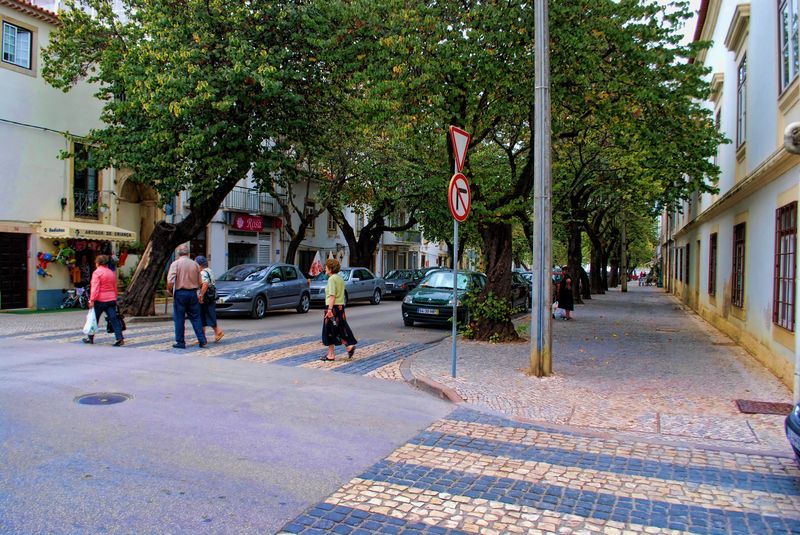
Another area of Rua dos Arcos in Tomar. This street runs in parallel with Varzea Grande and Avenida Cândido Madureira
Avenida António da Fonseca Simões in the City of Tomar starts near the area of Varzea Grande, close to the railway station of Tomar, near a former military base and the statue of the Unknown Soldier. This avenue directly connects to another avenue known as Avenida Combatentes da Grande Guerra (Avenue Combatants of the Great War). If you follow this avenue to the end, which is a long one, you will end up at a village called Cabeças.

This avenue called Avenida António da Fonseca Simões in Tomar, starts here. The forest seen on this photo is where I used to play when I was a kid, pretending that I was a knight from the Castle

On the left Avenida António da Fonseca Simões, is the Railway Station of Tomar, where people catch trains to Entroncamento and from there to other cities and villages of Portugal.
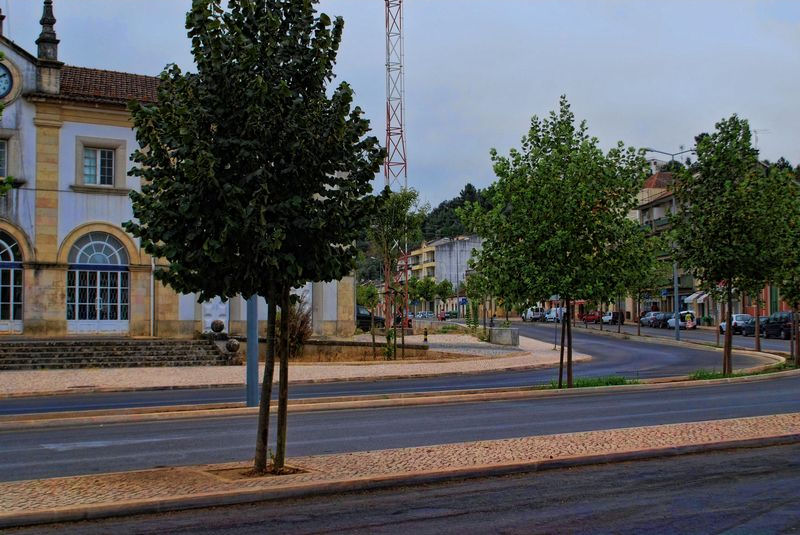
Another view of the Railway Station of Tomar and the start of Avenida António da Fonseca Simões in the City of Tomar in Portugal. If you follow this avenue to the end you will end up in a village called Cabeças
I have to say that I am a bit confused here. This is an avenue in Tomar which is called Rua Amorim Rosa, taking the name of a well know intellectual, writer and a teacher in a private college in Tomar. However at a certain point, though it looks like we are in the same avenue, after crossing the street Rua da Cascalheira it changes its name to Rua João Santos Simões. Anyway I believe the photos below are still of Rua Amorim Rosa, but if not please let me know.

Rua Amorim Rosa, for a small town like Tomar, is comparatively a long street which crosses Avenida Norton de Matos and Alameda Primeiro de Março, ending at Rua da Cascalheira
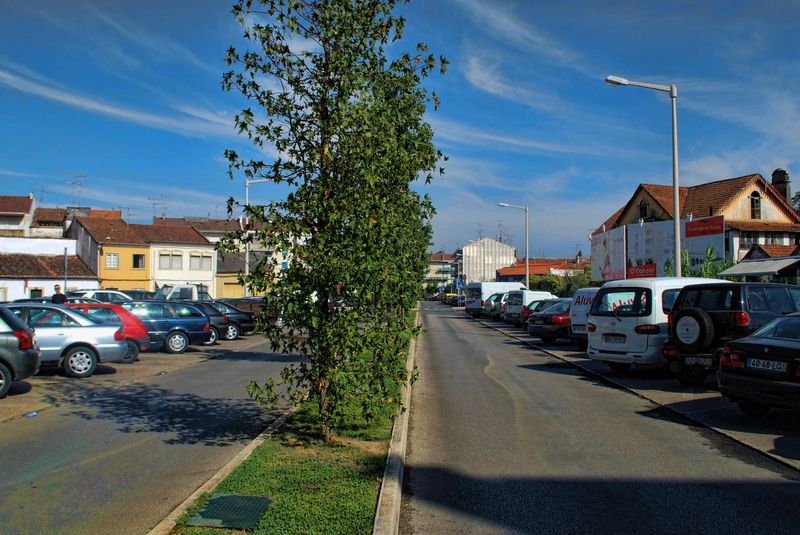
I believe this is still Rua Amorim Rosa but since there is no clear sign of where one street ends and another starts, may be this is already Rua João Santos Simões

Another view of what I believe to be Rua Amorim Rosa as it's continuation the the avenue that starts at Rua Carlos Campeão in the City of Tomar
This is an old cobblestone street stairs which is an extension of Rua da Cascalheira in Tomar. So I suppose this is the same street and that’s what I will call it for now. Logically no cars can use this street. It’s just a pedestrian lane that leads you to the sports pavilion, the soccer field and the Camping Park of Tomar, as well as to Mouchão Park. My mother’s apartment is nearby, so during my holidays in Tomar, I went down and climbed these stairs almost everyday.

Coming from my mother's apartment I used to walk down these stairs to go to different areas of the old town of Tomar, to the island of Mouchão Park and approach the banks of Nabão River

Similar area but a bit further down the stairs. From here I can go to the sports pavilion and soccer field of Tomar, enter Mouchão Park, cross the Old Bridge, etc

This is the same street stairs which I believe to be Rua da Cascalheira in Tomar, but this time I was pointing my camera to the opposite direction
At the end of this avenue in Tomar, which in Portuguese is called Avenida Cândido Madureira, the Seven Hills Forest begins, and it is also here where the statue of Henry the Navigator was erected. At this avenue you can also find the main Tourist Building, with vestiges of neo-renaissance style, despite the fact that it was built in the 20th century. For example, the tiles and sculptures of this building are replicas of the the 15th and 16th centuries. At Avenida Cândido Madureira, you can also find the House of Ceilings (Casa dos Tectos) which serves as the headquarters of the Professional School of Tomar. They teach Information Technology, Restoration and Graphic Arts. When I was a kid I used to live right next door to Casa dos Tectos.

On the left is the neo-renaissance Tourist Building at Avenida Cândido Madureira in Tomar. Behind me is the statue of Henry the Navigator and the entrance to the Seven Hills National Forest

Still Avenida Cândido Madureira and across the avenue is Casa dos Tectos (House of Ceilings). In the distance you can see the statue of Infante D. Henrique (Henry the Navigator) and the Seven Hills Forest
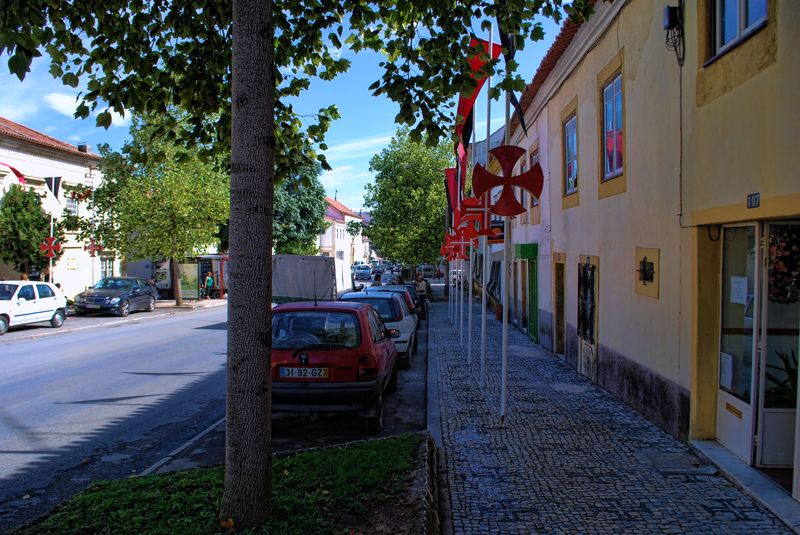
On my left at Avenida Cândido Madureira, is the House of Ceilings (Casa dos Tectos) which is now used as a professional school to teach Information Technology, Restoration and Graphic Arts
The City of Tomar (Cidade de Tomar) is also know as the Nabantina City (Cidade Nabantina) derived from the name Nabância, which was the former name of Tomar more than a thousand years ago. In regard to this street, some people confuse the names Rua Marquês de Tomar with Rua Marquês de Pombal. The only things in common with these two streets is that they are in Tomar, not too far away from each other and both were named after two portuguese nobleman, thought one was more famous that the other. Anyway these photos are from Rua Marquês de Tomar, a street that runs alongside Nabão River and Mouchão Park and heads in the direction of Hotel dos Templários and Varzea Pequena, which is a beautiful garden with a 19th century bandstand.

Rua Marquês de Tomar running alongside Nabão River. On the right you also see Vieira Guimarães House and at some distance is the Old Bridge of Tomar which crosses to town to the other side
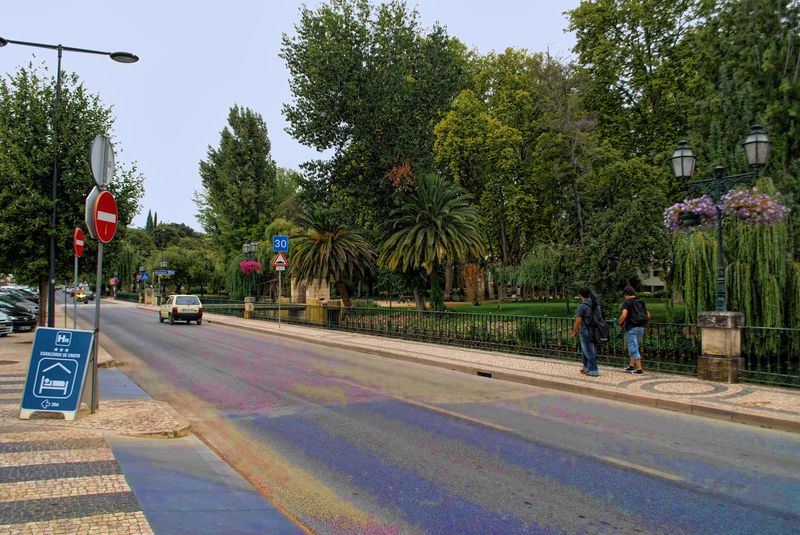
A different view of Rua Marquês de Tomar. On the right is Mouchão Park and in the distance, also on the right, are the gardens of Varzea Pequena, near Hotel dos Templários

Still Rua Marquês de Tomar in the City of Tomar. Nabão River is still visible and those white buildings in the distance are located at the more modern side of the town





























